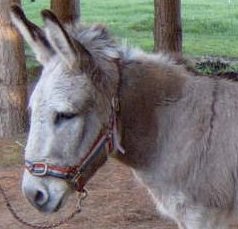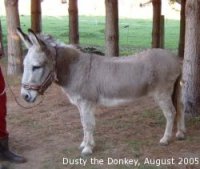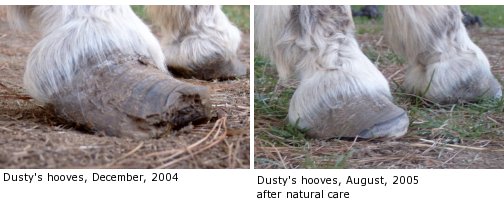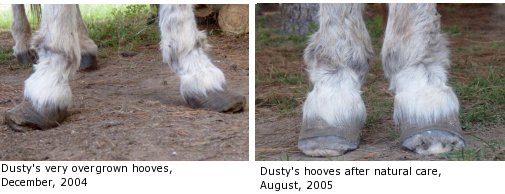

|
A r t i c l e s A n d C a s e
S t u d i e s
Natural Care of Donkeys

Donkeys differ in many ways to horses, - obviously the large ears are a giveaway - but in
terms of keeping them in good health, similar rules apply. Strasser Hoofcare Professional
Teresa Ramsey, of Natural Hoof, explains.
Aside from being gorgeous and full of character, donkeys are also very useful animals. They make kind and gentle pets for children and
adults, be used for riding or driving, and in many countries, they are a dependable working animal, able to carry or pull extremely heavy
loads. They can even calm down a herd of stroppy bulls, however this is not supported by the Donkey & Mule Society of NZ and Donkey and
Mule Protection Trust NZ see article.
But like any animal, owning a donkey is a huge commitment. According to the Donkey and Mule Society of New Zealand, donkeys need shelter, water and companionship, and as they can live for 30 to 40 years, the society advises you learn as much as you can about donkeys - preferably before you purchase.
As with horses, donkeys requires correct living conditions that meet their basic biological needs. This includes 24 hour turnout with a herd and adequate shelter, daily movement of up to 15km, and a physiologically correct hoof trim.
Like horses, a donkey's hoofcare is vitally important. This is because in a domestic situation, the rate of growth of the hoof often does not equal the rate of wear. This means, for donkeys and horses alike, the hoof is not wearing as quickly as it is growing. This is because the animals simply do not get enough movement on the right terrain.
However, even with regular hoof trimming, donkeys need to have a proper amount of movement to allow adequate circulation to the hoof in order to grow good quality horn. Therefore the donkey's owner must move him - ie; walk, ride or drive their donkey at least 15km per day. Providing a herd situation will help with some of that movement.
A donkey's hooves
Donkey hooves are very similar to horse's, except that they are smaller and the toes of the front hooves are steeper, usually around 55 degrees, which is the same toe angle as the hind hooves. Donkeys evolved on very hard terrain, and therefore their hooves have adapted to actually require a natural amount of movement (about 15km per day) on hard terrain in order for the hoof to properly expand. Expansion of the hoof allows proper shock absorption and blood circulation to the internal tissues of the hoof, which is vital for many things, including quality horn growth.
The hoof horn is made up of very fine spiral horn tubules, which are only just visible as vertical lines in the hoof capsule. Incredibly, a donkey's hoof has the same number of horn tubules as a large horse's hoof, but in a donkey's small hoof, they are more tightly packed, which makes donkey hooves tougher and more difficult to wear, especially on our soft NZ ground. This can lead to hoof problems if the donkey does not get enough movement on hard ground to wear its hooves, and/or the hooves are not properly trimmed regularly to simulate wear.
Donkey owners can simulate more natural living conditions for donkeys by placing gravel or river stones in gateways and areas the donkeys use frequently, such as where they eat their hay or feed, so that in winter, when the terrain is very wet, the donkey's hooves are still on firm terrain.
The importance of water
On the other hand, in dry weather it is essential that donkeys receive proper hydration of their hooves, to allow proper flexibility of the hoof, as a dry hoof cannot expand properly. If the hoof does not expand properly, shock absorption and blood circulation is impaired. Reduced hoof expansion means reduced circulation, which is essential for the internal tissues, called "corium", which the horn grows from. If blood is reduced because of a dry inflexible hoof, the corium will be unable to produce good quality horn, contributing to hoof problems.
In the wild, donkeys (as with horses) seek out a water source every day. When they drink, they walk into the water. As a result, the hooves have adapted to this and require moisture in order to stay flexible.
To allow for this in a domestic situation, it's important to soak the donkey's hooves in
water above the coronet for 10-15 minutes per day in dry weather. This can be done in a
hoof soaking bath, or by building a pond around the water trough, or while riding at the
beach, stopping to play in streams and rivers, etc. For more information about soaking
ideas, visit our hoof baths article.
Hoof problems in donkeys
Donkeys can suffer from the same hoof problems as horses, such as hoof cracks, founder, navicular, etc. Many donkeys develop a condition frequently called "seedy toe". This condition, as with horses, is caused by an incorrectly shaped hoof capsule that is overgrown or incorrectly trimmed. When the hoof capsule does not reflect a direct cast of the coffin bone, it places incorrect forces on the hoof capsule, white line, bones and internal tissues of the hoof, compromising proper horn growth and making it easier for ever-present bacteria to penetrate.
The only way to correct this condition permanently is to keep the hoof trimmed in its physiologically correct shape, which will remove the incorrect forces on the hoof, and allow for proper hoof expansion so good quality horn can grow. Then the donkey must receive it's natural amount of movement, approximately 15km per day, in order for the new hoof to grow down and the damaged area to grow out. It is also useful to soak the hoof with seedy toe in water and a splash of apple cider vinegar, which will kill bacteria but not dessicate the hoof horn as other substances such as copper sulphate will.
Owning a donkey, like owning a horse or any other animal, is a big commitment, that must be considered carefully. A certain amount of time will be required each day to move the donkey and soak its hooves, and its hooves need to be trimmed regularly and a proper environment provided in order to keep a donkey in good health.

Case Study: Dusty's Story:
Dusty is a 23-year-old donkey who could barely walk due to and incorrect living conditions
and incorrect hoofcare, resulting in very overgrown hooves. Strasser Hoofcare
Professional Penny Gifford, of Te Aroha, New Zealand, has been trimming Dusty's hooves and advising
his owners of the Strasser Method of care since December, 2004. He is now much more
comfortable and enjoys his walks.
Penny Gifford says: "Dusty is 23 yrs old and is now a much happier camper. After the first
trim he walked much more comfortably - he could barely walk before the first trim. He
still has a way to go but the improvement in him is remarkable."


Photos: Penny Gifford
Resources:
Donkey and Mule Society of New Zealand: www.donkey-mule.org.nz
www.lifestyleblock.co.nz
Essential reading: A Lifetime of Soundness, by Dr Hiltrud Strasser
Now
available from the Natural Hoof Shop
Submit an Article or Case Study
The more we share information, the better off our
horses are going to be. If you'd like to share your
story, please email the
editor.
Disclaimer: Natural Hoof
reserves the right to change or edit any part of
all articles and case studies submitted to this
website. Natural Hoof does not take any
responsibility for the content of any articles
and/or case studies and/or any misapplication of the information presented in any articles. Natural Hoof presumes readers consult a professional for more information about any topic covered in any Natural Hoof article.
Home | Articles | Hoof Trimmers | Clinics-Events | Brag | Classifieds |
Order | Links


|
|









